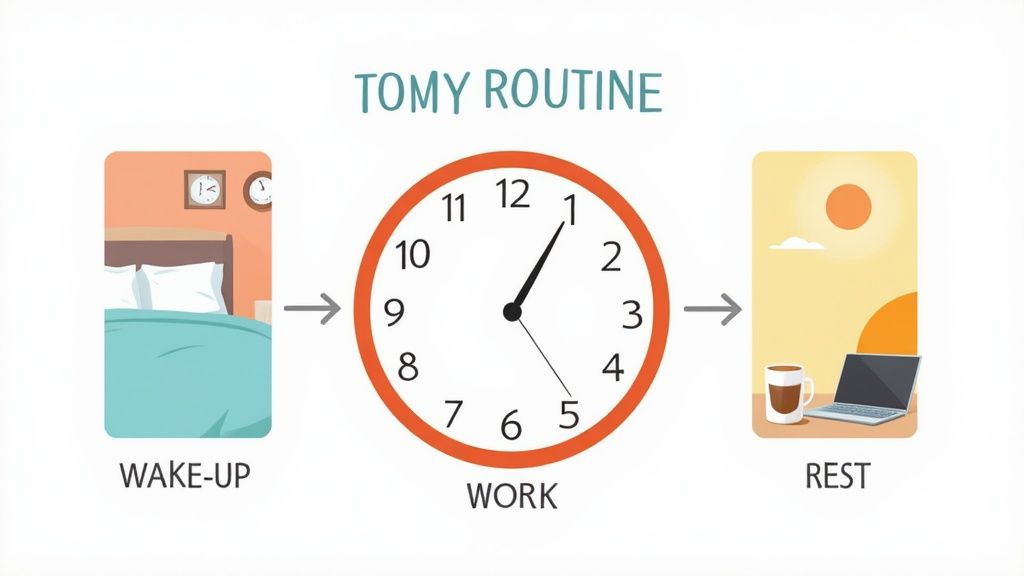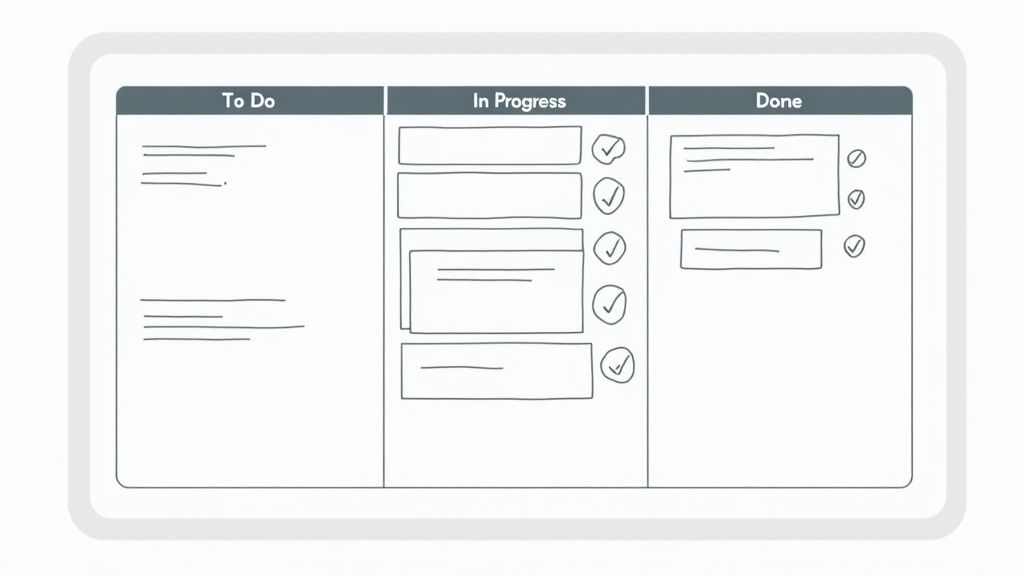
Remote Work Best Practices for Influencers in 2025
Published
In the dynamic landscape of influencer and digital marketing, the shift to remote work is not just a trend; it is the new standard for achieving peak creativity and flexibility. However, thriving outside the traditional office requires more than a strong internet connection. It demands a sophisticated set of skills, disciplined routines, and specific strategies to maintain productivity and foster collaboration. This guide cuts through the noise to provide a comprehensive roundup of remote work best practices, specifically tailored for the unique demands of marketing professionals.
We move beyond generic advice to offer actionable, detailed insights designed to help you excel. You will learn how to implement structured communication protocols, create an environment optimized for deep work, and leverage technology to stay connected and effective. We will cover everything from structuring your day for maximum output to setting firm boundaries that protect your work-life balance. Whether you are a seasoned remote marketer, a digital strategist, or seeking new opportunities in the field, these frameworks are designed to be immediately applicable.
Ultimately, mastering these practices is about building a successful, fulfilling, and sustainable career from anywhere. Beyond specific practices, a key to long-term success in remote roles is maintaining consistent motivation. Discover effective strategies for staying motivated and building a sustainable drive to complement the operational tactics discussed here. This article will equip you with the essential tools and mindsets to not just function, but truly flourish in a remote marketing role, ensuring you deliver exceptional results while enjoying the autonomy that remote work offers.
1. Establish Clear Communication Protocols
In a traditional office, communication often happens organically through hallway chats and desk drop-ins. Remote work removes these spontaneous interactions, making intentional, structured communication not just a preference but a necessity. Establishing clear communication protocols is one of the most fundamental remote work best practices because it replaces ambiguity with a predictable, efficient framework for interaction. This means defining exactly when, how, and where team members connect, ensuring everyone stays aligned without succumbing to notification overload.
Pioneers in remote work like GitLab have demonstrated the power of this approach. Their extensive communication handbook outlines everything from asynchronous-first principles to the appropriate use of specific channels, creating a single source of truth that minimizes confusion. Similarly, Shopify developed a "communication charter" to set firm expectations around response times and channel usage.
How to Implement Clear Communication Protocols
Creating a structured system prevents the common remote work pitfalls of either constant, distracting chatter or isolating silence. Here’s how to build your own:
Create a Team Communication Charter: Draft a living document that outlines your team's communication standards. This charter should specify the primary purpose of each tool. For example:
- Slack/Teams: For urgent, quick questions and real-time collaboration.
- Asana/Trello: For project updates, task assignments, and progress tracking.
- Email: For formal, external communication or company-wide announcements.
- Zoom/Google Meet: For scheduled, synchronous discussions like weekly check-ins or creative brainstorming sessions.
Define Response Time Expectations: Clearly state the expected turnaround time for messages on different platforms. For instance, a 2-hour response window on Slack during work hours, but a 24-hour window for non-urgent emails. This reduces anxiety for the sender and protects the recipient's focus time.
Encourage Status Indicators: Normalize the use of status indicators in communication apps (e.g., "In a meeting," "Deep work," "Available"). For influencer marketing roles, this is crucial when someone is on a live stream, in a client call, or deep in campaign analysis.
Key Insight: A well-defined communication protocol is not about restricting communication; it's about making every interaction more meaningful and efficient. It empowers team members by giving them the autonomy to disconnect and focus, knowing they won't miss critical information.
2. Create a Dedicated Workspace
When working from home, the lines between professional and personal life can easily blur, leading to burnout and decreased productivity. Creating a dedicated workspace is a powerful psychological tool that establishes a physical boundary between work and leisure. This is one of the most critical remote work best practices because it signals to your brain when it's time to focus and when it's time to switch off. It's not just about having a desk; it's about curating an environment optimized for concentration and efficiency.

This concept has been championed by ergonomic specialists like Herman Miller and popularized by organizational experts whose principles encourage intentional living. During the shift to remote work, companies like WeWork even offered home office setup consultations, recognizing that a well-designed space directly impacts performance. A designated workspace transforms a corner of your home into a hub of productivity, helping you mentally "commute" to work without leaving the house.
How to Implement a Dedicated Workspace
A functional and comfortable workspace minimizes distractions and supports your physical well-being. Even in a small apartment, you can carve out an effective work zone. Here’s how:
Prioritize Ergonomics: Invest in a supportive chair and a desk set to the proper height. Your monitor should be at eye level to prevent neck strain, and your arms should rest at a 90-degree angle. For optimal comfort and productivity, it's essential to understand how to set up an ergonomic workstation tailored to your needs.
Minimize Distractions: Position your desk away from high-traffic areas like the kitchen or living room. Use noise-canceling headphones or a white noise machine to block out ambient sounds, which is especially useful for influencer marketing professionals who need to concentrate on content creation or campaign analysis.
Optimize Your Environment: Ensure you have adequate lighting, preferably natural light, to reduce eye strain. Add personal touches like plants or artwork to make the space pleasant and motivating. Keep the area tidy and organized to maintain a clear and focused mind. You can learn more about setting up your home office for detailed guidance.
Key Insight: A dedicated workspace is more than just furniture; it's a productivity ritual. Physically leaving your workspace at the end of the day reinforces the end of your professional duties, allowing for true mental disconnection and a healthier work-life balance.
3. Implement Structured Daily Routines
The absence of a daily commute and the physical separation of an office can blur the lines between professional and personal life, leading to burnout or decreased productivity. Implementing a structured daily routine is one of the most effective remote work best practices as it reintroduces the clear boundaries and predictable rhythms that a traditional workday provides. This practice is about intentionally designing your day with defined start times, dedicated breaks, and a clear end, creating a framework that supports deep focus and prevents work from bleeding into personal time.

This concept is heavily promoted by productivity experts like Cal Newport, whose 'Deep Work' methodology emphasizes time-blocking to achieve high-concentration work. Tech giants have also embraced this; Microsoft's 'focus time' feature in Outlook automatically blocks calendars to protect employees from distractions, while Google's famous "20% Time" offers a structured way to integrate creative, self-directed work into the week.
How to Implement Structured Daily Routines
A well-designed routine acts as a scaffold for your day, providing support without being overly rigid. It helps manage energy levels and maintain momentum, which is vital for influencer marketing roles that require both creative and analytical thinking. Here’s how to build a routine that works:
Create "Bookend" Rituals: Establish a consistent morning routine to signal the start of your workday (e.g., getting dressed, making coffee, reviewing your schedule) and an end-of-day ritual to disconnect (e.g., tidying your workspace, planning the next day's tasks, closing all work tabs). This mentally separates work from leisure.
Use Time-Blocking or Pomodoro: Schedule blocks of time for specific tasks. For instance, block 9-11 AM for "Content Creation," 1-2 PM for "Email and Community Management," and 3-4 PM for "Campaign Analytics." Alternatively, use the Pomodoro Technique (25 minutes of focused work followed by a 5-minute break) to maintain high energy. You can learn more about this by exploring work-from-home time management strategies.
Schedule Your Breaks: Intentionally schedule short breaks, a proper lunch, and even a brief walk into your calendar. Treating breaks as mandatory appointments prevents you from skipping them, which is crucial for sustaining mental clarity and avoiding afternoon slumps.
Key Insight: A structured routine isn't about rigid control; it's about creating freedom through discipline. By defining the "when" and "what" of your workday, you give yourself permission to fully engage in your tasks and, just as importantly, to completely disengage when the day is done.
4. Prioritize Regular Video Calls and Virtual Meetings
While asynchronous communication is key to focused work, the complete absence of face-to-face interaction can lead to disconnection and misinterpretation. Prioritizing regular video calls and virtual meetings is one of the most vital remote work best practices because it reintroduces the human element essential for strong team dynamics. This isn’t about filling calendars with unnecessary meetings; it's about intentionally creating moments for synchronous, visual collaboration to build rapport and ensure clarity.
The global shift to remote work, accelerated in 2020, cemented platforms like Zoom and Microsoft Teams as workplace staples. Companies that thrived didn't just adopt the technology; they built strategic meeting cadences. For instance, many successful influencer marketing agencies schedule mandatory weekly video calls to review campaign performance and brainstorm creative concepts, recognizing that visual cues and shared energy are crucial for such collaborative tasks.
How to Implement Regular Video Calls and Virtual Meetings
A strategic approach to video conferencing fosters connection without causing "Zoom fatigue." The goal is to make screen time more impactful and less draining. Here’s how to do it effectively:
Establish a Meeting Cadence: Create a predictable schedule for different types of video meetings. For example:
- Weekly Team Syncs: A standing 30-45 minute call to align on priorities and roadblocks.
- Bi-Weekly One-on-Ones: Essential for managers to connect with direct reports on performance, career growth, and well-being.
- Monthly Virtual Socials: Optional, informal "virtual coffee breaks" or happy hours to foster camaraderie without a work-related agenda.
- Ad-Hoc Brainstorms: Use tools like Slack Huddles for quick, spontaneous video chats to resolve issues that are too complex for text.
Enforce Video Call Etiquette: Create and share guidelines to make meetings more professional and engaging. This includes muting when not speaking, using a neutral background, making eye contact with the camera, and coming prepared to contribute.
Leverage Platform Features: Use built-in tools to improve engagement. Utilize breakout rooms in Zoom or Teams for smaller group discussions during larger meetings. Encourage the use of the "raise hand" feature to manage conversations and record important sessions for team members in different time zones.
Key Insight: Intentional video communication is not a replacement for the office; it's a tool to strengthen a distributed team. The focus should be on the quality and purpose of interactions, not the quantity, ensuring that every call adds value and reinforces human connection.
5. Use Project Management and Collaboration Tools
While clear communication protocols set the stage for interaction, dedicated project management and collaboration tools provide the theater where the work actually happens. These digital platforms are essential for organizing tasks, tracking progress, and centralizing all project-related assets and conversations. Implementing these tools is a critical remote work best practices because they create a single source of truth, fostering transparency, accountability, and seamless coordination across a distributed team. Without them, project details get lost in chat threads and email chains, leading to missed deadlines and duplicated efforts.

The success of companies like Atlassian, founded by Mike Cannon-Brookes and Scott Farquhar, and Asana, co-founded by Dustin Moskovitz, is built on this very principle. Their platforms (Jira and Asana, respectively) empower remote teams by translating complex projects into clear, actionable steps. For influencer marketing, a visual platform like Monday.com can track campaign timelines, while an all-in-one workspace like Notion can house everything from creative briefs to performance analytics.
How to Implement Project Management and Collaboration Tools
Adopting a new tool is less about the software itself and more about the processes you build around it. A thoughtful implementation ensures the tool enhances productivity rather than adding another layer of complexity.
Establish Clear Workflows and Processes: Before rolling out a tool, map your existing workflows. Define how a task moves from conception to completion. For an influencer campaign, this could be:
Brief Created→Influencer Sourced→Content Approved→Campaign Live→Report Generated.Provide Comprehensive Onboarding and Training: Never assume team members will figure out a new platform on their own. Host a dedicated training session, create a simple "how-to" guide, and assign a "tool champion" who can answer questions.
Maintain Consistent Naming Conventions: Create and enforce a standard for naming projects, tasks, and files. For example,
[Campaign Name]_[Influencer Handle]_[Content Type]_[Date]. This simple discipline makes assets instantly searchable and prevents organizational chaos. To further enhance teamwork and streamline projects in a remote setting, consider exploring specific strategies for collaboration tools. For instance, these Notion for teams best practices can offer valuable insights.
Key Insight: The best tool is not the one with the most features, but the one your team actually uses consistently. Focus on creating simple, repeatable processes within a chosen platform to build a transparent and accountable work environment.
6. Maintain Work-Life Balance Through Boundaries
When your home doubles as your office, the line between professional duties and personal life can blur into nonexistence. The always-on nature of digital marketing roles, with their constant stream of notifications and global time zones, exacerbates this challenge. Maintaining work-life balance through firm boundaries is one of the most critical remote work best practices because it directly combats burnout and preserves long-term productivity. It involves intentionally creating physical, digital, and mental separations that allow you to fully disengage from work and recharge.

This concept has gained significant traction globally, exemplified by France's "right to disconnect" law, which protects employees from after-hours emails. Companies like Volkswagen have also famously configured servers to stop sending emails after work hours. In the remote-first world, pioneers like Buffer champion these policies by encouraging transparent conversations about time off and workload, proving that strong boundaries lead to a more sustainable and effective workforce.
How to Implement Strong Work-Life Boundaries
Creating these separations is an active, ongoing process, not a one-time setup. It requires clear communication and consistent habits. Here’s how to build a healthier work-life integration:
Establish a "Digital Commute": Create a ritual that signals the start and end of your workday. This could be a 15-minute walk before you log on, or listening to a specific podcast after you log off. This mental transition replaces the physical journey to and from an office.
Implement a Digital Shutdown: Turn off all work-related notifications on your phone and computer at a set time each day. For influencer marketing professionals who manage multiple social platforms, using separate browsers or app profiles for work versus personal accounts can be a game-changer.
Communicate Your Availability Clearly: Be explicit with your team about your working hours in your calendar and status messages. This manages expectations and empowers your colleagues to respect your time, just as you respect theirs. For instance, clearly state, "Online 9 AM - 5 PM EST; will respond to messages tomorrow."
Schedule Personal Time with Intention: Block out personal appointments, breaks, and family time in your calendar with the same commitment you give to work meetings. This visual reminder protects your personal life from being overwritten by professional demands.
Key Insight: Work-life balance isn't about achieving a perfect 50/50 split every day. It's about having the control and clear boundaries needed to be fully present in whichever part of your life you're in, preventing professional creep from diminishing your personal well-being.
7. Focus on Results and Outcomes Rather Than Hours
In a traditional office, presence is often mistaken for productivity. Managers can see who is at their desk, creating a flawed correlation between hours worked and value delivered. Remote work dismantles this illusion, demanding a shift towards what truly matters: results. Focusing on outcomes is one of the most transformative remote work best practices because it grants autonomy and trusts professionals to manage their own time, as long as they deliver high-quality work on schedule. This approach values impact over activity, fostering a culture of accountability and high performance.
Companies like Netflix and GitLab have championed this philosophy. Netflix's renowned culture of "freedom and responsibility" empowers employees to take ownership of their work without micromanagement of their hours. Similarly, GitLab operates on a Results-Only Work Environment (ROWE) model, where performance is evaluated solely on accomplished goals, not on time spent online. This model is perfectly suited for roles in influencer marketing, where the success of a campaign is measured by engagement metrics and ROI, not by the hours a strategist spends at their keyboard.
How to Implement a Results-Oriented Approach
Moving from a time-based to an outcome-based model requires clear goals and mutual trust. It empowers team members to work when they are most productive, leading to better results and improved well-being. Here’s how to put it into practice:
- Establish Clear, Measurable Goals: Use frameworks like OKRs (Objectives and Key Results) to define what success looks like for each project or quarter. For an influencer campaign, a Key Result could be "Achieve a 5% average engagement rate across all sponsored posts," rather than "Work 40 hours this week."
- Define Deliverables, Not Just Tasks: Focus on the tangible outputs of work. Instead of tracking time spent on outreach, track the number of new influencer partnerships secured or the volume of high-quality user-generated content produced.
- Hold Regular Progress Check-ins: Schedule brief, recurring meetings to discuss progress toward goals, not to monitor activity. These sessions should be forward-looking, focusing on overcoming obstacles and aligning on next steps.
- Document and Celebrate Achievements: When a goal is met or a significant milestone is reached, celebrate it publicly. This reinforces the value of the results themselves and motivates the entire team by highlighting what successful outcomes look like.
Key Insight: Shifting focus from hours to outcomes is not about working less; it's about working smarter. It gives talented professionals the freedom to deliver exceptional results in a way that best suits their workflow, leading to higher engagement, greater innovation, and superior performance.
8. Invest in Professional Development and Learning
In an office setting, learning often happens through osmosis, by observing senior colleagues, or through company-organized, in-person training. Remote work can inadvertently create skill silos, making proactive investment in professional development a critical practice. Investing in continuous learning is one of the most strategic remote work best practices because it empowers employees to stay relevant, engaged, and motivated, directly combating the career stagnation that can arise from physical isolation. This means intentionally creating pathways for skill acquisition and knowledge sharing.
The rise of massive open online courses (MOOCs) and professional learning platforms has made this more accessible than ever. Pioneers like Coursera and LinkedIn Learning have built vast libraries of high-quality courses, enabling professionals to upskill from anywhere. Companies like Amazon have institutionalized this with programs like Career Choice, which pre-pays tuition for employees to learn new skills for in-demand fields, recognizing that employee growth is company growth.
How to Implement Professional Development and Learning
A structured approach to learning ensures that development is aligned with both individual career goals and company objectives, preventing random, unfocused efforts. Here’s how to build a culture of continuous learning:
Create Personalized Learning Plans (PLPs): Work with each team member to outline specific skills they want to develop over the next quarter or year. This plan should link directly to their role and future aspirations. For an influencer marketing specialist, this could involve mastering a new analytics tool or learning advanced video editing.
Dedicate and Protect Learning Time: Formally block out time in the company calendar for learning, whether it's "Development Fridays" or a few protected hours each week. This signals that the organization values growth over constant output and gives employees permission to invest in themselves without guilt.
Leverage Diverse Learning Formats: Combine different learning methods to keep things engaging. Offer subscriptions to platforms like Udemy for practical skills, fund participation in virtual industry conferences, and create internal peer-to-peer learning sessions where team members teach each other valuable skills.
Encourage "Learn and Share" Sessions: Ask team members to present a brief summary of what they learned from a recent course or workshop during a team meeting. This reinforces their own learning, disseminates knowledge across the team, and sparks new ideas.
Key Insight: Professional development in a remote setting is not just a benefit; it's a retention strategy. It shows employees they are valued beyond their immediate tasks, providing a clear path for career progression within the company, even when they are not physically present.
9. Build and Maintain Professional Networks Virtually
In a physical office, networking can occur spontaneously during lunch breaks, industry meetups, or local conferences. Remote work eliminates these traditional avenues, making proactive, virtual networking a critical skill rather than an afterthought. Learning to build and maintain professional networks virtually is one of the most impactful remote work best practices because it ensures career growth, knowledge sharing, and opportunity discovery are not hindered by a lack of physical proximity. This involves intentionally using digital tools to forge and nurture meaningful professional relationships.
Industry leaders and platforms have championed this shift. LinkedIn, co-founded by Reid Hoffman, has become the de facto digital space for professional identity and connection. Similarly, the rise of virtual event platforms like Hopin and professional communities on Twitter and Meetup demonstrates a collective move toward digitizing professional engagement. These platforms provide the infrastructure for remote workers to stay connected and relevant in their fields.
How to Implement Virtual Networking Strategies
Building a strong professional network from a home office requires a deliberate and consistent approach. It’s about quality interactions, not just accumulating contacts. Here’s how to effectively network remotely:
Schedule Virtual Coffee Chats: Be intentional about relationship-building. Reach out to colleagues, former coworkers, or new LinkedIn connections and invite them to a 15-30 minute virtual coffee chat. Keep it informal and focused on getting to know them, their work, and how you might support each other.
Actively Participate in Digital Communities: Join and contribute to industry-specific Slack channels, LinkedIn Groups, or Twitter communities. Don't just lurk; share valuable content, answer questions, and engage in discussions to establish yourself as a knowledgeable and helpful peer. For those seeking new opportunities, this is a key step; you can explore tips on how to get a remote job on influencermarketingjobs.net.
Attend Virtual Industry Conferences: Treat virtual events as you would in-person ones. Attend keynotes, participate in breakout sessions, and use the event's networking features to connect with speakers and other attendees. Follow up with a personalized message on LinkedIn afterward.
Become a Content Contributor: Share your expertise by posting insightful articles on LinkedIn, contributing to a blog, or sharing relevant case studies. This positions you as a thought leader and attracts connections to you, flipping the networking dynamic from outbound to inbound.
Key Insight: Virtual networking is not about replicating in-person events online; it’s about leveraging digital platforms to create more focused, intentional, and geographically limitless connections. Consistency is more important than intensity.
Remote Work Best Practices Comparison
| Strategy | Implementation Complexity 🔄 | Resource Requirements ⚡ | Expected Outcomes 📊 | Ideal Use Cases 💡 | Key Advantages ⭐ |
|---|---|---|---|---|---|
| Establish Clear Communication Protocols | Moderate – requires setup and updates | Low to Moderate – mainly time and tools | Improved clarity, fewer miscommunications | Remote teams needing structured interaction | Predictable communication, trust building |
| Create a Dedicated Workspace | Low to Moderate – physical setup needed | Moderate – ergonomic furniture & tech | Increased focus and productivity | Individuals working from home | Better work-life separation, reduced physical strain |
| Implement Structured Daily Routines | Low – personal discipline dependent | Low – mostly time management | Enhanced productivity and work-life boundaries | Self-managed workers seeking consistency | Reduces decision fatigue, supports sleep patterns |
| Prioritize Regular Video Calls & Virtual Meetings | Moderate – scheduling and etiquette | Moderate – reliable tech & setup | Maintains personal connection and engagement | Distributed teams needing human interaction | Improves collaboration, reduces isolation |
| Use Project Management & Collaboration Tools | Moderate to High – onboarding & integration | Moderate to High – software subscriptions | Better organization, visibility, and accountability | Teams coordinating complex or multi-project workflows | Centralizes info, automates workflows |
| Maintain Work-Life Balance Through Boundaries | Low to Moderate – discipline and culture | Low – personal time/space management | Prevents burnout, improves mental health | Employees managing remote work stress | Strengthens relationships, long-term productivity |
| Focus on Results and Outcomes Rather Than Hours | Moderate – requires goal setting & trust | Low to Moderate – management framework | Higher autonomy, quality-focused work | Flexible workers aiming for output over hours | Increases satisfaction, accommodates styles |
| Invest in Professional Development and Learning | Moderate – planning and time allocation | Moderate – course fees and time | Skill growth, career advancement | Professionals seeking continuous upskilling | Enhances adaptability, expands networks |
| Build and Maintain Professional Networks Virtually | Moderate – ongoing engagement required | Low to Moderate – platforms access/time | Expanded networks and opportunities | Individuals needing remote professional connections | Global reach, cost-effective networking |
Integrating These Practices for a Thriving Remote Career
Navigating the landscape of remote work is more than just logging on from home; it's a dynamic skill that requires intention, strategy, and continuous refinement. The comprehensive framework detailed in this article, covering everything from communication protocols to virtual networking, provides the essential building blocks for a successful career in the digital and influencer marketing sectors. Adopting these remote work best practices is not about achieving perfection overnight. Instead, it is about committing to a process of iterative improvement, creating systems that support both your professional output and your personal well-being.
The journey from surviving to thriving in a remote role is built on the deliberate application of these principles. By establishing clear boundaries, you transform your home into a productive sanctuary rather than a 24/7 office. By prioritizing results over hours logged, you align your efforts with what truly matters, fostering trust and autonomy with your team and leadership. This shift in focus is particularly critical in creative and strategic fields like influencer marketing, where impact is measured by engagement, campaign success, and brand growth, not just time spent at a desk.
Weaving the Threads Together: From Theory to Action
The power of these nine practices lies in their synergy. A structured daily routine is amplified by a dedicated workspace. Clear communication protocols are made seamless through the effective use of project management tools. Your commitment to professional development is enriched by a strong virtual network. Think of each practice as a gear in a larger machine; when one is neglected, the entire system can feel clunky and inefficient. When they work in harmony, they create a smooth, powerful engine for career momentum.
To truly integrate these concepts, consider a phased approach. Don't try to overhaul your entire work life in a single day. Instead, identify one or two areas that need the most immediate attention.
- Is communication feeling disjointed? Start by proposing a standardized agenda format for your team's next virtual meeting.
- Is work-life balance a struggle? Implement a hard stop to your workday for one week and see how it feels.
- Feeling isolated? Schedule two virtual coffee chats with colleagues or industry contacts this month.
Small, consistent actions build sustainable habits. Track your progress. What's working? What needs adjustment? This reflective practice is a cornerstone of mastering the art of remote work.
The Long-Term Impact: Building a Sustainable and Fulfilling Career
Embracing these remote work best practices offers benefits that extend far beyond daily productivity. It positions you as a self-motivated, reliable, and forward-thinking professional, qualities that are highly sought after by leading companies and agencies in the digital space. It demonstrates your ability to adapt, communicate effectively across distances, and take ownership of your results. These are not just remote work skills; they are modern leadership skills.
By investing in these areas, you are building a career that is resilient, flexible, and aligned with the future of work. You are creating a professional life that offers not just a paycheck, but also a sense of accomplishment, connection, and balance. The ultimate goal is to craft a work-life integration that fuels your ambition without draining your energy, allowing you to consistently deliver high-impact work in the exciting world of influencer marketing. This strategic approach will not only help you excel in your current role but will also make you an undeniable asset for your next great opportunity.
Ready to find a role that embraces these forward-thinking work principles? Explore the curated remote and hybrid opportunities on Influencer Marketing Jobs, a platform dedicated to connecting top talent with leading brands and agencies in the industry. Visit Influencer Marketing Jobs to discover positions that value the skills and best practices you've learned today.